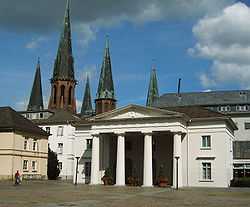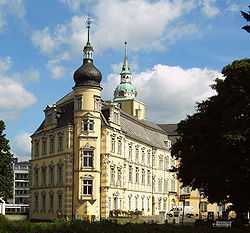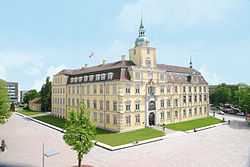Oldenburg
| Oldenburg | ||
|---|---|---|
 | ||
| ||
 Oldenburg | ||
| Coordinates: 53°08′38″N 8°12′50″E / 53.14389°N 8.21389°ECoordinates: 53°08′38″N 8°12′50″E / 53.14389°N 8.21389°E | ||
| Country | Germany | |
| State | Lower Saxony | |
| District | Urban district | |
| Subdivisions | 33 boroughs, separated into nine census tracts | |
| Government | ||
| • Lord Mayor | Gerd Schwandner (since 2006) (Ind.) | |
| Area | ||
| • Total | 102.96 km2 (39.75 sq mi) | |
| Elevation | 4 m (13 ft) | |
| Population (2012-12-31)[1] | ||
| • Total | 157,706 | |
| • Density | 1,500/km2 (4,000/sq mi) | |
| Time zone | CET/CEST (UTC+1/+2) | |
| Postal codes | 26001–26135 | |
| Dialling codes | 0441 | |
| Vehicle registration | OL | |
| Website | www.oldenburg.de | |
Oldenburg (German pronunciation: [ˈɔldənbʊʁk] (![]() ); Low German: Ollnborg; Saterland Frisian: Ooldenbuurich) is an independent city in the state of Lower Saxony, Germany. During the French annexation (1811–1813) in the wake of the Napoleonic war against Britain, it was also known as Le Vieux-Bourg in French. The city is situated at the Rivers Hunte and Haaren, in the northwestern region between the cities of Bremen in the east and Groningen (Netherlands) in the west. It has a population of 157,267 (May 2011).[2] The formal name is Oldenburg (Oldenburg) or Oldenburg (Oldb) (spoken: Oldenburg in Oldenburg) to distinguish it from the city of Oldenburg in Holstein.
); Low German: Ollnborg; Saterland Frisian: Ooldenbuurich) is an independent city in the state of Lower Saxony, Germany. During the French annexation (1811–1813) in the wake of the Napoleonic war against Britain, it was also known as Le Vieux-Bourg in French. The city is situated at the Rivers Hunte and Haaren, in the northwestern region between the cities of Bremen in the east and Groningen (Netherlands) in the west. It has a population of 157,267 (May 2011).[2] The formal name is Oldenburg (Oldenburg) or Oldenburg (Oldb) (spoken: Oldenburg in Oldenburg) to distinguish it from the city of Oldenburg in Holstein.
The city is the place of origin of the House of Oldenburg. Before the end of the German Empire (1918), it was the administrative centre and residence of the monarchs of Oldenburg.
History
Archaeological finds point to a settlement dating back to the 8th century. The place was first mentioned in 1108 as Aldenburg in connection with Elimar I (also known as Egilmar I) who is now commonly seen as the first count of Oldenburg. The town gained importance due to its location at a ford of the navigable Hunte river. Oldenburg became the capital of the County of Oldenburg (later Duchy, Grand Duchy, and Free State), a small state in the shadow of the much more powerful Hanseatic city of Bremen.[3]
In the 17th century, Oldenburg was a wealthy town in a time of war and turmoil and its population and power grew considerably. In 1667, the town was struck by a disastrous plague epidemic and, shortly after, a fire destroyed Oldenburg. The Danish kings, who were also counts of Oldenburg at the time, were not much interested in the condition of the town and it lost most of its former importance. In 1773, Danish rule ended. It was only then that the destroyed buildings in the city were rebuilt in a neoclassicist style.[3] (In German, the ‘neoclassicist style’ of that period would usually be called klassizistisch, while neoklassizistisch specifically refers to the classicist style of the early 20th century.)
After German Emperor Wilhelm II was forced to abdicate following the exhaustion and defeat of the German Empire in World War I, monarchic rule ended in Oldenburg as well with the abdication of Grand Duke Frederick Augustus II of Oldenburg (Friedrich August II von Oldenburg) on 11 November 1918. The Grand Duchy of Oldenburg now became the Free State of Oldenburg (Freistaat Oldenburg), the city remained the capital.
In 1945, after World War II, the State of Oldenburg was part of the British zone of occupation. The British military government of the Oldenburg region resided in the city. Several displaced persons camps were set up in the city that had suffered only 1.4% destruction during the bombing campaigns of World War II.[4] About 42,000 refugees migrated into Oldenburg, which raised the number of residents to over 100,000. In 1946, the Free State of Oldenburg was dissolved, and the area became the 'Administrative District' of Oldenburg (Verwaltungsbezirk Oldenburg) as part of the newly formed federal German state of Lower Saxony (Niedersachsen). The city was now capital of the district. In 1978, the district was dissolved and succeeded by the newly formed Weser-Ems administrative region (Regierungsbezirk Weser-Ems), again with the city as administrative capital. The State of Lower Saxony dissolved all regierungsbezirks by the end of 2004 in the course of administrative reforms.
Demography
| Year | 1502 | 1667 | 1702 | 1769 | 1816 | 1828 | 1837 | 1855 | 1871 |
|---|---|---|---|---|---|---|---|---|---|
| Population | ~ 2,300 | ~ 4,300 | ~ 5,000 | 6,959 | 6,278 | 6,800 | 9,280 | 11,370 | 13,928 |
City government
Local elections take place every five years. The city council (Stadtrat) has 50 seats. The lord mayor is elected directly by the citizens.
- Political parties in Oldenburg (Oldb) and their percentages of votes in past city council elections[5]
| election year |
SPD | Bündnis ’90/ Die Grünen |
CDU | Die Linke | Freie Wähler/ FW-BFO |
FDP | Piraten Partei |
NPD |
|---|---|---|---|---|---|---|---|---|
| 2001 | 40.1% | 13.6% | 30.5% | 3.9% | 2.8% | 8.2% | - | - |
| 2006 | 32.7% | 21.2% | 26.0% | 7.2% | 5.4% | 6.3% | - | - |
| 2011 | 34.0% | 27.3% | 20.6% | 6.1% | 3.1% | 3.0% | 2.8% | 1.1% |
- Resulting distribution of seats in the city council
| election year |
total seats |
SPD | Grüne | CDU | Linke | FW | FDP | Piraten | WFO | NPD |
|---|---|---|---|---|---|---|---|---|---|---|
| 2001 | 50 | 21 | 7 | 15 | 2 | 1 | 4 | - | - | - |
| 2006 | 50 | 16 | 11 | 13 | 4 | 3 | 3 | - | - | - |
| 2011 | 50 | 17 | 14 | 10 | 3 | 2 | 1 | 1 | 1 | 1 |
Economy and infrastructure
Transport


- The city centre of Oldenburg is surrounded by a ring of freeways (autobahns) consisting of A 28, A 29 and A 293. Because of this, Oldenburg is connected to the nation-wide network of federal autobahns, as well as to the international E-road network (German: Europastraßen)
- Oldenburg Central Station, Oldenburg (Oldb) Hauptbahnhof, is at the intersection of the railway lines Norddeich Mole—Leer—Oldenburg—Bremen and Wilhelmshaven—Oldenburg—Osnabrück, with Intercity services to Berlin, Leipzig and Dresden and InterCityExpress services to Frankfurt and Munich.
- Oldenburg is only about half an hour drive from Bremen Airport (about 50 km | 31 miles). Other international airports nearby are Hamburg Airport (160 km | 100 miles) and Hannover-Langenhagen Airport (170 km | 106 miles).
- The small Hatten Airfield, (Flugplatz Oldenburg-Hatten ICAO airport code: EDWH), is located about 17 km south-west of Oldenburg. It serves to small aircraft (private planes, gliders, balloons, and helicopters). A flight training school is also located there, and small planes can be chartered. Scenic flights can be booked as well.
- Oldenburg is connected to shipping through the Küstenkanal, a ship canal connecting the rivers Ems and Weser. With 1.6 million tons of goods annually, it is the most important non-coastal harbour in Lower Saxony.
- Bicycles play a very important part in personal transport.
Agriculture
The city is surrounded by large agricultural areas, about 80% of which is grassland. There are farms near and even a few within city limits. Predominant agricultural activities of the region are the cultivation of livestock, especially dairy cows and other grazing animals, crops such as grains for food and animal feed, as well as asparagus, corn, and kale.
Cultural life
Recurring cultural events
- Kultursommer (summer of culture), series of free musical and other cultural events in the city centre during summer holiday season in July.
- CSD Nordwest (Christopher Street Day) parade of the regional Lesbian, Gay, Bisexual, Transgender community in June, with up to 10,000 participants (since 1995).
- Stadtfest, a three-day festival of the city centre in August/September, comprises gastronomical offerings and rock and pop music performances on various stages.
- Oldenburg International Film Festival, privately organised film festival in September, focussed on independent film and film makers. The festival is funded through public subsidies and private sponsoring.
- Kramermarkt, fun fair at the Weser-Ems Halle on ten days in September/October. The tradition of this annual volksfest dates back to the 17th century, when the Kramermarkt was a market event at the end of the harvest.
- Oldenburger Kinder- und Jugendbuchmesse (KIBUM), an exhibition of new German language children's and youth literature, takes place over 11 days in November. A non-commercial fair organised by the city government in cooperation with the public library and the university library. In the course of the fair, a prize, the Kinder- und Jugendbuchpreis, is awarded to a debuting author or illustrator.
Points of interest
- Core city centre, a large pedestrianised shopping destination for the region.
- Oldenburg State Theatre, oldest theatre in Oldenburg, first opened in 1833.
- Oldenburg Castle, city centre, until 1918 residence of the monarchic rulers of Oldenburg, today a museum. A public park, the Schlosspark, is nearby.
- Weser-Ems Halle, exhibition and congress centre with outdoor fair area, located in Oldenburg Donnerschwee.
- Small EWE Arena, a 4,000-seat sports and event hall, located near main railway station, first opened in 2005, was home arena of the EWE Baskets Oldenburg basketball club.
- Large EWE Arena, a 6,852-seat sports and event hall, located near main railway station, first opened in 2013, is home arena of the EWE Baskets Oldenburg basketball club.
- Botanischer Garten Oldenburg, a public botanical garden maintained by the university.
Crime
Hate crimes
On November 26th 2013, tombstones and a funeral hall at the Oldenburg Jewish cemetery were vandalized by swastika graffiti. Local police had arrested suspects.[6]
Media
- Nordwest-Zeitung (NWZ) Oldenburg-based daily newspaper, also provides local editions in neighbouring counties
- Free weekly newspapers delivered to households, mainly for ads and inserts: Hunte-Report (Wednesdays+Sundays), Sonntagszeitung (Sundays).
- Diabolo free weekly city magazine / listings magazine
- Mox free biweekly event listings magazine (from the same publisher as Diabolo)
- Alhambra-Zeitung bimonthly leftist, anti-fascist magazine
- Oldenburger Stachel local alternative magazine (discontinued)
- Oldenburgische Wirtschaft monthly magazine of the Oldenburg Chamber of Industry and Commerce (Industrie- und Handelskammer)
Radio and television
- Oldenburg Eins non-commercial public-access cable TV and radio station (live streams available online)
- Norddeutscher Rundfunk (NDR), public TV and radio broadcaster (part of the ARD), maintains a regional studio in Oldenburg.
- Radio Bremen, public TV and radio broadcasting organisation (part of the ARD network), covers news of the northwestern region, including Oldenburg.
- Radio FFN, commercial radio broadcaster, maintains a regional studio located in the NWZ building.
Online
- Oldenburger Lokalteil, features and op-ed pieces on local culture and politics (in German)
- Nordwest-Zeitung TV Local video news clips published by the Nordwest-Zeitung
Education
Tertiary education
There are two public universities in Oldenburg:
- The Carl von Ossietzky University of Oldenburg was founded in 1973 based on a previous college for teacher training, the Pädagogische Hochschule Oldenburg, which had a history in Oldenburg dating back to 1793. The university was officially named after Carl von Ossietzky in 1991. As of January 2012, it has almost 10,700 students, a scientific staff of 1,105, as well as 923 technical and administrative staff.[7] A new faculty of medicine and health sciences was established in 2012 as part of the newly founded European Medical School Oldenburg-Groningen, a cooperation with the University of Groningen (Netherlands) and local hospitals.[8]
- The Jade University of Applied Sciences (Jade-Hochschule) The former Fachhochschule Oldenburg (until 1999) was founded in 1971, a merger of the previous engineering academy with the nautical college in Elsfleth. Oldenburg already had a history of construction engineering training dating back to 1882. Starting in 2000, the Fachhochschule had been part of multiple re-organisations involving several UAS (Fachhochschule) in the northwestern region. A relaunch under the name Jade-Hochschule took place in 2009 (previously: Fachhochschule Oldenburg/Ostfriesland/Wilhelmshaven). The Jade-Hochschule now comprises branches in three towns: Oldenburg, Elsfleth, and Wilhelmshaven. Based in Oldenburg are the departments of architecture, construction engineering and construction management, geodesy, as well as the institute of hearing aid technology and audiology. There are about 2,000 students in the Oldenburg branch.[9] (The Elsfleth branch offers Bachelor’s degree courses in nautical science, international logistics, and harbour management. The Wilhelmshaven branch offers courses in engineering, business management, and media management.)
Privately managed institutions of higher education:
- Since 2004 the Berufsakademie Oldenburg, a college of cooperative education, offers a B.Sc. degree course in business informatics. The dual-system course combines practical vocational training at one of the partnering local companies with periods of academic studies.
- The Private Fachhochschule für Wirtschaft und Technik, a regional college of cooperative education, maintains a branch in Oldenburg offering Bachelor’s degree courses with integrated vocational training in electrical engineering and mechatronics.
Other:
- The Oldenburg branch of the Lower Saxony police academy (Polizeiakademie Niedersachsen) maintains a study facility in Oldenburg preparing candidates for a career in higher-middle-level or higher-level police service.
Primary and secondary education
- Gymnasium Graf-Anton-Guenther School
- Wirtschaftsgymnasium Oldenburg
- Cäcilienschule Oldenburg
- Liebfrauenschule Oldenburg
- Herbartgymnasium Oldenburg
- Altes Gymnasium Oldenburg
- Neues Gymnasium Oldenburg
- Gymnasium Eversten
- IGS Flötenteich
- Helene Lange Schule Oldenburg (IGS)
- Realschule Hochheider Weg
- Real - und Hauptschule Osternburg
- Realschule Ofenerdiek
- Kath. Grundschule Lerigauweg
Events
Oldenburg hosted the 2007 Fistball World Championship.
International relations
Oldenburg is twin towns with following cities and districts: [10]
-
 Denmark: Taastrup, since 1978
Denmark: Taastrup, since 1978 -
 France: Cholet, since 1985
France: Cholet, since 1985 -
 Netherlands: Groningen, since 1989
Netherlands: Groningen, since 1989 -
 Russia: Makhachkala, Dagestan, since 1989
Russia: Makhachkala, Dagestan, since 1989 -
.svg.png) : Mecklenburg-Vorpommern: District of Rügen, since 1990
: Mecklenburg-Vorpommern: District of Rügen, since 1990 -
 Israel: Mateh Asher, since 1996
Israel: Mateh Asher, since 1996 -
 England: Kingston upon Thames, since 2010
England: Kingston upon Thames, since 2010
See also
- Straße der Megalithkultur - tourist route from Osnabrück to Oldenburg via some 33 Megalithic sites.
References
- ↑ Landesbetrieb für Statistik und Kommunikationstechnologie Niedersachsen, Fortgeschriebene Einwohnerzahlen zum 31. Dezember 2012
- ↑ "Zensus 2011 – Bevölkerung Kreisfreie Stadt Oldenburg (Oldenburg), Stadt am 9. Mai 2011" (PDF) (in German). Landesbetrieb für Statistik und Kommunikationstechnik Niedersachsen. 2013. Retrieved 10 June 2013.
- ↑ 3.0 3.1
 One or more of the preceding sentences incorporates text from a publication now in the public domain: Anonymous (1911). "Oldenburg". In Chisholm, Hugh. Encyclopædia Britannica 20 (11th ed.). Cambridge University Press. p. 72
One or more of the preceding sentences incorporates text from a publication now in the public domain: Anonymous (1911). "Oldenburg". In Chisholm, Hugh. Encyclopædia Britannica 20 (11th ed.). Cambridge University Press. p. 72 - ↑ Ulrich Schneider: Niedersachsen 1945, p. 95. Hannover 1985
- ↑ Source: Official results of elections published on the official website of the city of Oldenburg.
- ↑ http://antisemitism.org.il/article/83285/%D7%91%D7%99%D7%AA-%D7%A7%D7%91%D7%A8%D7%95%D7%AA-%D7%99%D7%94%D7%95%D7%93%D7%99-%D7%97%D7%95%D7%9C%D7%9C
- ↑ Statistics published on the CvO University’s web site, retrieved in January 2012
- ↑ Info published on the university's web site, retrieved in August 2012.
- ↑ Statistics published on the Jade-Hochschule website, retrieved in January 2012
- ↑ Description of international cooperation at the official website of the city of Oldenburg (in German)
External links
| Wikimedia Commons has media related to Oldenburg (Oldenburg). |
- Official city website
- Official Oldenburg tourist information centre
-
 Oldenburg travel guide from Wikivoyage
Oldenburg travel guide from Wikivoyage - Oldenburg International Film Festival website of the annual festival of independent film
- Oldenburg Panoramas 360-degree panning views
- Straßen von Oldenburg Drive-through videos of Oldenburg streets (German)
- Alt Oldenburg Large collection of historical photographs of Oldenburg (German)
- Oldenburg Association for Family Research e.V. genealogy of emigrants from Oldenburg
- Oldenburgische Landschaft (German), Oldenburg-based public body of municipalities located within the area of the former State of Oldenburg, tasked to maintain historically significant landmarks, landscapes, and art, as well as to promote local culture.
| |||||||||||||||||
